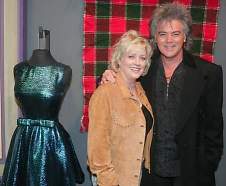|
His parents, John and Hilda Stuart, and sister, Jennifer, and childhood friend Butch Hodgins mingled in a Tennessee State Museum crowd that included Sonny James, Manuel, Dierks Bentley, Barbara Fairchild and several members of Diamond Rio. As Marty showed Gladys Flatt, 91, the items that once belonged to her late husband, Lester, she told him, "I miss him, and I know you do. My Lord, I miss him." Marty's wife, Connie Smith, was moved to tears by the display featuring the suit he wore when the young teen arrived in Nashville. "The one that got me more than anything was when I walked around the corner and saw that suit and how little he was to be put in the middle of all of this," she says. When Marty saw it, he hugged the dressed mannequin and said, "Boy, you did all right." About the exhibit, Marty says, "I wish you could do life like this and edit out the bad stuff and just hit the high stuff. I've never seen this comprehensively stretched out, and it's an awesome exhibit. It's been an awesome life." Marty began collecting country music memorabilia in the early 1980s and now has more than 20,000 pieces. His mother began collecting Marty's things much earlier. "I watched him from the essay that he wrote in the sixth grade where he said he wanted to do it," she says. "I stopped and thought, 'We've got something ahead here.' But it's been a good journey." Says Kathy Mattea, "This is a man who saves everything, and it's our good fortune that he has. It makes me think how many things have I forgotten to save along the way. What a rich history, and how nice to see how much he appreciates his own history. It's like he knew when he was doing it what a special life it was." By Beverly Keel |
 Tuesday night's preview party of "Sparkle & Twang: Marty Stuart's American Musical Odyssey" must have felt like an episode of This Is Your Life for Marty. His spectacular country music artifacts collection contains many of his own items, including his sixth-grade essay proclaiming his country music ambitions, and several of those who helped his dream come true were on hand.
Tuesday night's preview party of "Sparkle & Twang: Marty Stuart's American Musical Odyssey" must have felt like an episode of This Is Your Life for Marty. His spectacular country music artifacts collection contains many of his own items, including his sixth-grade essay proclaiming his country music ambitions, and several of those who helped his dream come true were on hand.